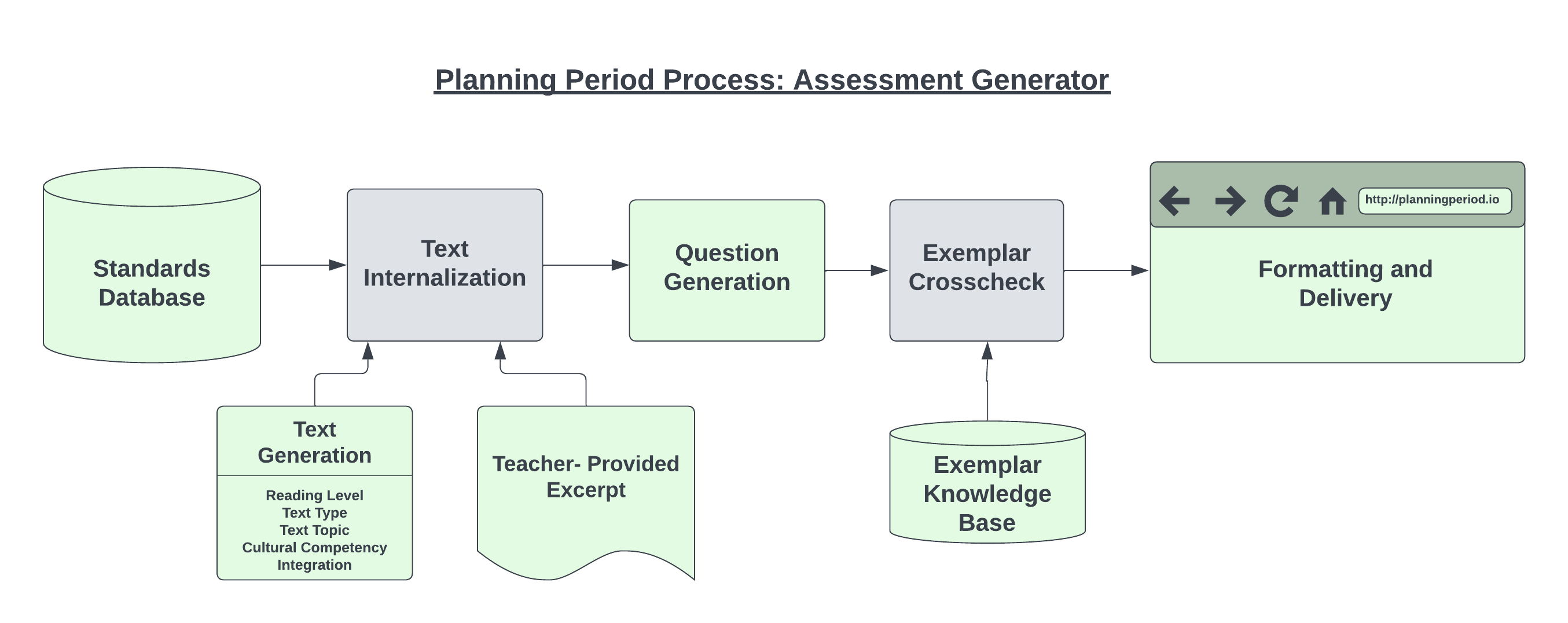So You Want to Lesson Plan with AI?

If you’re at school right now, you’ve probably heard your colleagues buzzing about AI in your grade level team meetings. Though most of the conversation around the use of AI in education revolves around how to ensure that students do not use it to cheat on their assignments, there is a lot of potential for tools like Open AI’s ChatGPT to save teachers a considerable amount of time and effort when it comes to lesson planning.
From creating classroom quizzes, to generating funny stories for your classroom read-aloud, to even creating a full-blown lesson plan on the water cycle, ChatGPT and other tools like it can offer you almost unlimited access to lesson components as fast you can hit the enter button. Nevertheless, mastering these tools requires lots of effort, and a deeper understanding of how AI systems work in order to develop lesson resources that are actually usable in your classroom.
With this blog post, my hope is to introduce you to the awesome but tricky world of lesson planning with AI, starting with how teachers are currently use it, how to use it right, and how our tools can save you time and effort so that hopefully, you don’t get to spend your sundays lesson planning at the local coffee shop like I did during my first years of teaching (seriously, they named their latte after me).
How teachers are using AI for lesson planning right now:
On one of their latest blog posts, OpenAi , the creators of ChatGPT shared that teachers are using ChatGPT to build quizzes, give students feedback on assignments, and even adjust lesson materials to a student’s learning level. These experiences are not dissimilar to what we learned when we interviewed teachers, instructional coaches, and education system leaders when we started developing and testing our suite of tools. However, our partners kept coming back to two key factors that are missing in the national conversation about AI in schools: making sure that AI usage is standards-aligned, and that teaching resources were responsive to the context of the student’s communities and their interests.
In our search for AI-powered lesson planning tools, we could not find any that helped you start with the goal in mind, the learning standards that as a teacher, you are tasked to cover every lesson. We also found that many of the tools out there would base their lesson resources on trying to get students to gain a baseline understanding of concepts, rather than actually learning and consistently practicing the subject knowledge and skills that are required for every student to master at every single grade level. Essentially, we found that most AI-powered education tools ignore the foundations on which our education system operates on. Our ability to systematically ensure that all students can gain a standardized and collective set of capabilities, as they are required by state and federal laws in order to ensure equitable learning.
In addition, we found that most AI-powered tools out there offer limited opportunity to actually include the student, their community, and their needs in the contents of the lesson that they would be receiving. So we made it our goal to ensure that our tools take into account what the teacher knows about their students and their community, requiring them to consider that context, along with standards, are at the center of their lesson planning cycle.
Lesson planning for internalization, not compliance
The application of ChatGPT in lesson planning carries within it the struggle between two different mindsets about what this task entails in the life of the modern educator: Whether or not a lesson plan is a compliance document that helps school leaders ensure that teachers are teaching the expected contents, or an actual tool that helps the teacher internalize the goals, concepts and strategies they will employ in their classroom in order to help their students practice and eventually master grade and subject-specific skills.
This struggle has existed much prior to the dawn of commercial AI, as I recall it coming up in countless conversations with principals and instructional leadership teams during my time as a teacher trainer, bonding over our struggle to coach novice teachers out of lesson planning on Powerpoint or Google Slides, and instead really spending time practicing lesson planning using one of highest forms or critical thinking: Writing.
“Writing out your lesson plan requires that you organize and deeply think through your ideas and how you will bring them into the classroom” is one of the wisest points I remember one of my school partners in the Bronx brought up while we discussed how to best help their teachers improve. When it comes to implementing AI-powered lesson planning into the pedagogical process, our tools must help the teacher both save time, and deeply internalize their lesson components so that they can best use them in their classroom, and the reality is that simple ChatGPT prompts can’t help them do that. This need to help teachers actually lesson plan during their planning period, is at the heart of our reasoning, and the namesake for our suite of tools.
GPT vs ChatGPT
So, how can we make ChatGPT truly work in service of standards-aligned and context responsive pedagogy? The answer lies in first understanding how the model works and how to ensure its best results. Let’s start by breaking down GPT.
GPT stands for Generative Pre-trained Transformer and it is the architecture developed by Open AI specifically to complete tasks that require Natural Language Processing or NLP. The underlying components that make up this system are:
- Generative: Meaning that it is designed to specifically generate text.
- Pre-trained: Meaning that it has been trained on vast amounts of text data from many different fields of knowledge.
- Transformer: This is the specific type of mechanism that many of these NLP models use, and it entails determining the most important words in a user prompt or request, and then trying to understand the context of the request by looking at the secondary words around those primary words, ultimately connecting its understanding with the vast systems of knowledge that it has been pre-trained on, and providing a response that is appropriate to the request and its context.
Simply put, GPT models operate in a similar fashion to our students’ brain when they encounter difficult or new vocabulary while reading a text, they use the most important words, or context clues in the sentence, along with their understanding of the geographical, cultural and historical setting in which they are read, to approximate a definition for the words, and with it, develop their comprehension of the text.
Enter ChatGPT, this is openAI’s fine-tuned model of GPT that has been given the ability to hold conversational interactions. ChatGPT is optimized to generate human-like conversational responses, not instructional materials. Though of course, with certain tips and tricks, you can definitely get ChatGPT to give you great responses to use in your classroom. However, more often than not, getting ChatGPT to give you ready-to-use lesson components may require as much time as coming up with them yourself. If you want to attempt it, here are some of the principles behind building really effective prompts.
How we do it at Planning Period
A powerful prompt like the one above is likely going to give teachers a great worksheet for the students to practice their comprehension of the text, but does this mean that teacher would have to go through this process every single time? Also what if I wanted to align it to the common core ELA standard that we are honing on this week? How can I ensure that the questions are grade level appropriate and match the rigor expected to show standards mastery? What if I wanted my students to practice standards mastery on a text they’ve never seen before, or an excerpt from a story they’ve read in the past?
This is why we built Planning Period, because we felt that tools like ChatGPT were not enough to help teachers create standards-aligned lesson components, using the curriculum and materials that they already know that their students respond to. When you’re using any of our tools you’re not pushing a button to send in a prompt, you’re activating a multi-layered system that was designed with the inputs of real educators and school leaders to get standards-aligned, context responsive lesson resources that you can then integrate into any part of your lesson.
Here are the three components that make our system unique:
We’ve built a standards knowledge base: Our suite of tools are designed in the same way teachers design their lesson, following the backwards design methodology. Before any resource is created, GPT must understand the end goal of the lesson and what students need in order to achieve mastery.
Our tools require your context: We believe that at the heart of standards-aligned instruction is teacher-knowledge. When teachers incorporate the topics they and their students are passionate about into their lesson planning, academic achievement skyrockets. This is why we prefer to have teachers input their own lesson plans, their own text excerpts, and details such as their student’s names and geographical contexts. From these inputs, our tools create the essential learning resources to take your lesson to the next level.
Multiple-layers of resource creation: While many lesson planning tools try to deliver the fastest and cheapest results possible in order to cut cost and appear time-efficient, our tools generate resources in under two minutes while taking your request through multiple layers of teacher knowledge and exemplars. Following the image above, you'll notice that when you use our Assessment Generator to measure an ELA standard, our system would trigger 5-8 different processes to create your desired resource. Starting with developing a deep understanding of said standard, then reading and analyzing the text excerpt that you provide (or you can have it come up with one based on your preferences), generate standards-aligned questions based on said text. Next, it will use a reading leveler database to ensure that the questions are appropriate for the reading level of your classroom, and finally deliver the final result in a concise document that you can edit in our platform or download for your own use.
New teachers, veterans, and instructional coaches
While AI offers tools to ease the heavy load of the teaching profession, the heart of education remains with the educators. AI is here to assist, not replace. In this evolving landscape, educators continue to be the central architects of their lessons, with AI as a supportive tool in their kit.
This is why we believe Planning Period will be the tool of choice for new teachers, veteran teachers, and instructional coaches alike.
For new teachers, navigating the early years is intense. Properly integrated AI tools, like Planning Period, support both their efficacy and their learning. It's a tool to ensure lessons align with standards and resonate with students, emphasizing that the primary planning responsibility always remains with the educator.
Veteran teachers, seasoned in their craft, can see Planning Period as a complementary asset. While they've mastered effective teaching, AI offers a fresh lens, ensuring content remains dynamic and relevant. The key is using AI as an enhancer, keeping their foundational methods intact.
Instructional coaches, juggling a heavy coaching load, find Planning Period invaluable. It's a means to swiftly generate quality exemplars for teachers and foster collaborative discussions. Yet, the core of coaching—a human touch and shared expertise—remains untouched by AI's integration.
Let us equip you with AI tools that complement your expertise and elevate your teaching. Dive into Planning Period today – where educators remain at the heart of every lesson.
